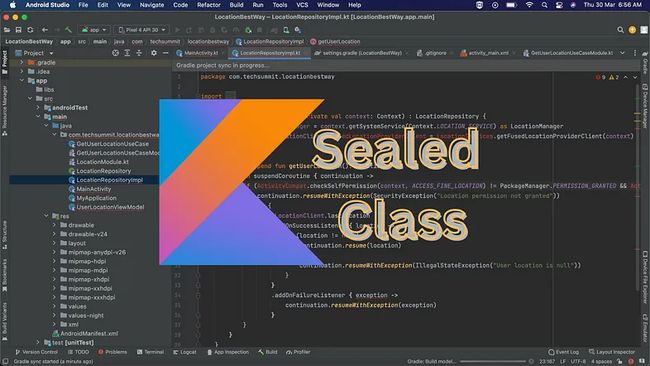解锁 Kotlin 中密封类(Seal Class)的能力:设计模式与代码组织的优化
解锁 Kotlin 中密封类(Seal Class)的能力:设计模式与代码组织的优化
多年来,我参与了多个项目,深知编写清晰、易维护代码的价值。最近在一个涉及大量数据类型处理的项目中,我发现使用密封类极大地提高了数据的组织和管理效率。此外,密封类有助于强制类型安全,从而使代码更加健壮,减少了错误的可能性。在本文中,我将分享在 Kotlin 中使用密封类的经验,以及如何利用它们实现设计模式和优化代码组织。

什么是密封类?
密封类是 Kotlin 中使用sealed关键字标记的类。它用于定义一组封闭的子类。它允许您在受限的类层次结构中定义预定义且有限的子类。密封类的子类在密封类本身内部定义,每个子类必须声明为 inner 或 data 或 class,不允许使用其他修饰符。
密封类的语法:
Kotlin 中密封类的语法如下:
sealed class SealedClassName {
// Subclasses
class SubclassName1 : SealedClassName()
class SubclassName2 : SealedClassName()
// ...
}
密封类的用途:
密封类在许多情况下非常有用,特别是当您有一组固定的可能需要表示的类时。以下是一些常见的密封类用例:
表示操作的结果:
密封类的一个常见用例是表示操作的结果。例如,我们可以定义一个名为 Result 的密封类,它有两个子类:Success 和 Error。
sealed class Result {
data class Success(val data: String) : Result()
data class Error(val message: String) : Result()
}
通过这样的定义,我们可以使用 when 表达式处理 Result 的所有可能情况,如下所示:
fun handleResult(result: Result) {
when(result) {
is Result.Success -> println(result.data)
is Result.Error -> println(result.message)
}
}
状态机:
密封类的另一个常见用例是表示状态机的状态。例如,我们可以定义一个名为 State 的密封类,其子类表示游戏的不同状态。
sealed class State {
object Initial : State()
object Running : State()
object Paused : State()
object Finished : State()
}
通过这样的定义,我们可以使用 when 表达式处理 State 的所有可能情况,如下所示:
fun handleState(state: State) {
when(state) {
is State.Initial -> println("The game is starting...")
is State.Running -> println("The game is running...")
is State.Paused -> println("The game is paused...")
is State.Finished -> println("The game is finished!")
}
}
处理 UI 状态:
密封类在处理 Android 应用程序中的不同 UI 状态时非常常见。例如,您可以定义一个名为 ViewState 的密封类,其子类表示屏幕的不同 UI 状态。
有了这个定义,我们可以使用 when 表达式处理 State 的所有可能情况,如下所示:
sealed class ViewState {
object Loading : ViewState()
data class Success(val data: List<String>) : ViewState()
data class Error(val message: String) : ViewState()
}
通过这样的定义,我们可以使用 when 表达式处理 ViewState 的所有可能情况,如下所示:
fun handleViewState(viewState: ViewState) {
when(viewState) {
is ViewState.Loading -> showLoadingIndicator()
is ViewState.Success -> showData(viewState.data)
is ViewState.Error -> showError(viewState.message)
}
}
以下是更多使用密封类实现设计模式的例子:
状态模式:
状态模式用于表示对象的状态以及根据该状态应执行的行为。密封类可以用于定义对象的不同状态,每个状态都可以有自己的行为。
sealed class State {
abstract fun handle()
}
object IdleState : State() {
override fun handle() {
// Do nothing
}
}
object ActiveState : State() {
override fun handle() {
// Do something when in active state
}
}
object InactiveState : State() {
override fun handle() {
// Do something when in inactive state
}
}
通过这样的定义,我们可以使用 when 表达式处理对象的所有可能状态并执行相应的行为,如下所示:
fun handleState(state: State) {
when(state) {
is IdleState -> state.handle()
is ActiveState -> state.handle()
is InactiveState -> state.handle()
}
}
访问者模式:
访问者模式用于向现有类添加新行为,而无需修改这些类。密封类可用于定义访问者将访问的类的层次结构,每个子类可以实现接受访问者的方法。
sealed class Element {
abstract fun accept(visitor: Visitor)
}
class ConcreteElementA : Element() {
override fun accept(visitor: Visitor) {
visitor.visitConcreteElementA(this)
}
}
class ConcreteElementB : Element() {
override fun accept(visitor: Visitor) {
visitor.visitConcreteElementB(this)
}
}
interface Visitor {
fun visitConcreteElementA(element: ConcreteElementA)
fun visitConcreteElementB(element: ConcreteElementB)
}
通过这样的定义,我们可以通过创建实现 Visitor 接口并重写 Element 的每个子类方法的新类来实现新行为。
工厂模式:
工厂模式用于在不将实例化逻辑暴露给客户端的情况下创建对象。密封类可以用于定义工厂将创建的不同类型的对象。
sealed class ViewState {
object Loading : ViewState()
data class Success(val data: List<String>) : ViewState()
data class Error(val message: String) : ViewState()
}
sealed class Product {
abstract fun getDescription(): String
}
class ConcreteProductA : Product() {
override fun getDescription(): String {
return "This is product A"
}
}
class ConcreteProductB : Product() {
override fun getDescription(): String {
return "This is product B"
}
}
object ProductFactory {
fun createProduct(type: String): Product {
return when(type) {
"A" -> ConcreteProductA()
"B" -> ConcreteProductB()
else -> throw IllegalArgumentException("Unknown product type")
}
}
}
通过这样的定义,您可以通过在 ProductFactory 上调用 createProduct 方法来创建新的产品。
工厂方法模式:
工厂方法模式用于创建对象而不指定其具体类型。密封类可以用于定义可以创建的对象类型。
sealed class Animal {
abstract fun makeSound()
}
class Dog : Animal() {
override fun makeSound() {
println("Woof!")
}
}
class Cat : Animal() {
override fun makeSound() {
println("Meow!")
}
}
object AnimalFactory {
fun createAnimal(type: String): Animal? {
return when (type) {
"dog" -> Dog()
"cat" -> Cat()
else -> null
}
}
}
通过这样的定义,您可以通过使用适当的类型调用 createAnimal 方法来创建不同类型的动物,如下所示:
val dog = AnimalFactory.createAnimal("dog") // Dog
val cat = AnimalFactory.createAnimal("cat") // Cat
val rabbit = AnimalFactory.createAnimal("rabbit") // null
策略模式:
策略模式用于在运行时选择算法。密封类可以用于定义可选的不同策略。
sealed class SortingStrategy {
abstract fun sort(array: IntArray)
}
object BubbleSort : SortingStrategy() {
override fun sort(array: IntArray) {
// implementation of bubble sort
}
}
object MergeSort : SortingStrategy() {
override fun sort(array: IntArray) {
// implementation of merge sort
}
}
class Sorter(private var strategy: SortingStrategy) {
fun setStrategy(strategy: SortingStrategy) {
this.strategy = strategy
}
fun sort(array: IntArray) {
strategy.sort(array)
}
}
通过这样的定义,您可以创建一个排序器对象并在运行时设置其策略,如下所示:
val sorter = Sorter(BubbleSort)
sorter.sort(arrayOf(3, 2, 1)) // array is now sorted using bubble sort
sorter.setStrategy(MergeSort)
sorter.sort(arrayOf(3, 2, 1)) // array is now sorted using merge sort
装饰器模式:
装饰器模式用于在不改变对象结构的情况下动态添加功能。密封类可以用于定义基本对象及其装饰器类。
sealed class Coffee {
abstract fun getCost(): Double
abstract fun getDescription(): String
}
class BasicCoffee : Coffee() {
override fun getCost(): Double {
return 2.0
}
override fun getDescription(): String {
return "Basic coffee"
}
}
abstract class CoffeeDecorator(val coffee: Coffee) : Coffee()
class Milk(coffee: Coffee) : CoffeeDecorator(coffee) {
override fun getCost(): Double {
return coffee.getCost() + 0.5
}
override fun getDescription(): String {
return coffee.getDescription() + ", with milk"
}
}
class Sugar(coffee: Coffee) : CoffeeDecorator(coffee) {
override fun getCost(): Double {
return coffee.getCost() + 0.25
}
override fun getDescription(): String {
return coffee.getDescription() + ", with sugar"
}
}
通过这样的定义,我们可以通过组合不同的装饰器来创建不同类型的咖啡,如下所示:
val basicCoffee = BasicCoffee()
val coffeeWithMilk = Milk(basicCoffee)
val coffeeWithSugar = Sugar(basicCoffee)
val coffeeWithMilkAndSugar = Sugar(Milk(basicCoffee))
结论:
密封类是 Kotlin 的一项强大特性,可帮助您编写更清晰、更简洁和更富表现力的代码。它们提供了一种定义受限类层次结构的方式,可用于各种用途,包括更好的代码组织和实现设计模式。通过使用密封类,您可以创建更易于阅读和维护的代码,且更容易扩展和修改。